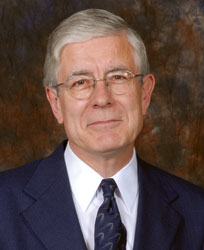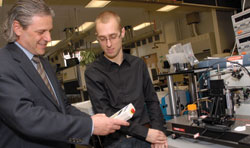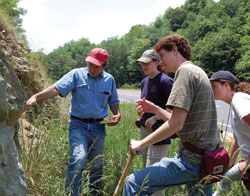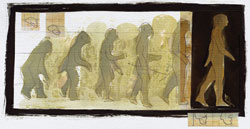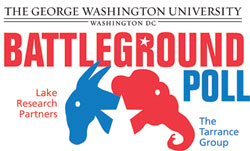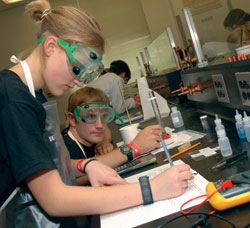As soaring energy prices and environmental challenges cast dark clouds over much of the world, the sun offers enduring solutions. This fall, The George Washington University positioned itself as a global leader in the fast-growing solar power field by launching the interdisciplinary Institute for the Analysis of Solar Energy. The institute focuses on the economic, technical, and policy issues associated with developing and deploying solar power to meet global energy needs. The scholarly institute will engage faculty members and graduate students across the University, including those in business, economics, engineering, geography, public policy, public administration, and chemistry, in collaborative research projects. The institute was established within the Columbian College of Arts and Sciences through a combination of private, corporate, and foundation funds, including support from media mogul and environmentalist Ted Turner. “The new institute will draw on the expertise of our faculty and the advantages of our location in the heart of the public policy community,” GW President Steven Knapp says. “Its creation illustrates the University’s commitment to play a leading role in informing the national conversation on alternative sources of energy.” According to Peg Barratt, dean of Columbian College of Arts and Sciences, “GW’s researchers will concentrate on questions beyond analyzing the science of solar energy generation to exploring its many unanswered questions, such as how to transmit energy across the nation, what possible cost scenarios could look like, and how to meet the demands of peak power times.” Dr. Barratt led the way as the institute quickly developed from an alumnus-generated idea in February 2008 to a $2.5 million funded, one-of-a-kind enterprise by the fall. The institute gathered its first set of research proposals in September. Highlights include analyzing solar deployment issues such as intermittency, when the sunlight is interrupted by cloud cover; solar cost analysis and comparison with traditional energy sources; and new storage and fuel methods using solar. “We’ll be examining solar’s possibilities, the roadblocks, the policy, and related issues,” Dr. Barratt states. “We’re building the resources to provide trusted, scientifically sound information and analysis of solar energy to assist our nation’s policy makers as they develop our country’s energy policy.” Spearheading the effort is international solar expert Ken Zweibel, executive director of the institute, who has served as a solar industry leader for the past three decades. “In the next 15 years, the United States can substantially reduce its dependence on foreign oil, as well as its carbon emissions, by using solar as a major part of its energy supply, and our new GW institute is committed to drafting that roadmap,” he says. Zweibel comes to GW from PrimeStar Solar Inc. in Golden, Colo., a solar power manufacturing company he co-founded. He previously worked for 27 years at the Department of Energy’s National Renewable Energy Laboratory Solar Program in Colorado, where he headed up efforts to develop solar technology for low-cost electricity. Zweibel is the author of two books and numerous articles on solar energy, including “The Solar Grand Plan,” published in the January 2008 edition of Scientific American. The ambitious plan calls for the installation of solar panels over vast areas of land in the sun-rich Southwestern United States, the construction of high-voltage, direct-current power distribution lines to transmit the solar electricity across the country, and the transition of transportation to plug-in electric hybrids to use the new carbon-free energy. “There is a real sense of urgency about energy and environmental challenges,” Zweibel says. “The increased price of conventional energy suggests we revisit alternatives. This institute—fueled by the tremendous knowledge base at GW—will help contribute to that re-examination.” “The Institute for the Analysis of Solar Energy has a perfect home here at GW,” Dr. Barratt concurs. “It gathers experts in many fields, joins faculty and students in collaborative research, and puts trusted information about solar energy before a large group of stakeholders here in D.C. and around the world.” —Jamie L. Freedman
Record Gift Will Advance GW Cancer ResearchIn what represents the largest individual gift ever to The George Washington University and its Medical Center, Cyrus and Myrtle Katzen have committed $10 million to advance a wide range of cancer initiatives. The gift will establish The Dr. Cyrus and Myrtle Katzen Cancer Research Center, enhancing recruitment of top scholars in the field and development of innovative approaches to battling and treating cancer. It is the latest expression of close and long-standing ties between the Katzens and GW. Six members of the Katzen family have attended GW, including four who earned medical degrees. In addition, the Katzens have given more than $1.3 million to the University over the years, primarily in support of the Medical Center and the GW Cancer Institute. Dr. Katzen often has spoken of the high quality of care his first wife, Sylvia, received at GW Hospital during her 10-year battle with cancer. She died in 1980. Robert Siegel, MD, professor of medicine and director of the Division of Hematology/Oncology, will chair the board of directors to be established on behalf of The Dr. Cyrus and Myrtle Katzen Cancer Research Center. Cyrus Katzen is the owner and president of Mozel Development Corp. and Culmore Realty Co. Tysons Corner and Crystal City in Virginia are among the many properties he has helped develop. He also has had successful careers in banking and dentistry. He holds a degree in dentistry from Georgetown University and is known for inventing an automatic processing system for medical and dental X-ray film.
Renowned Aerospace Expert to Lead Engineering School
David S. Dolling traces his love of flight to building model airplanes and watching air shows as a child growing up in England. When a teenager, he joined the Royal Air Force Cadets, a program that enables young people to learn firsthand about aviation, and the rest was history. “I became fascinated by the engineering and science behind flight—it’s fair to say that the fascination has never left me,” says Dr. Dolling, who started as dean of GW’s School of Engineering and Applied Science on Sept. 1. Dr. Dolling comes to GW with a wealth of qualifications. Most recently, he served as associate dean for academic affairs, Joe C. Walter Jr. Chair in Engineering, and professor of aerospace engineering and engineering mechanics at the University of Texas, Austin. Dr. Dolling is a fellow of both the American Institute of Aeronautics and Astronautics and the United Kingdom’s Royal Aeronautical Society, has held a number of leadership positions in the American Institute of Aeronautics and Astronautics, and was appointed to the Engineering Accreditation Commission. While Dr. Dolling spent the past 25 years at the University of Texas, he says the decision to come to GW was an easy one. “I was attracted by the combination of existing GW qualities and by the clear potential that the School of Engineering and Applied Science has to play a larger role locally and on the national stage,” he says. “The motivation, energy, and enthusiasm of the students and faculty played a crucial role, as did the proximity to government, industry, and the high-tech corridor in Northern Virginia. “A commitment has been made at the highest levels of GW to strengthen the School of Engineering and Applied Science,” he adds. “An opportunity to play a leadership role in that endeavor is very exciting.” Although Dr. Dolling says it is too soon for him to have formed highly articulated objectives, his preliminary goals for the school include strengthening and expanding its undergraduate and graduate offerings, making it an increasingly attractive education and research destination for students, taking full advantage of the Virginia Campus, and forging more research collaborations with industry, government, research institutes, and other schools. Dr. Dolling’s research concerns supersonic and hypersonic fluid dynamics. “A key element in determining the aerodynamics of an airplane—the forces and movements acting on the plane due to its motion through the air—is whether or not it is traveling above or below the speed of sound,” he explains. Supersonic speeds are in the range of Mach 2 to 5, or two to five times the speed of sound. Hypersonic speeds are typically Mach 5 and above. “In this field, a fluid can be a gas or liquid, so air is considered a fluid,” he says. “Therefore, fluid dynamics is the study of the dynamics of airflow over an airplane, missile, or rocket.” He currently is the principal investigator on a five-year, $5 million program sponsored by the U.S. Air Force on scramjet propulsion technologies. One of the long-range outcomes of his research could be less expensive access to space, he explains. “Vehicles are now propelled into space by rockets, which, because they carry both fuel and an oxidizer, tend to be large and heavy.” In contrast, a scramjet-propelled vehicle would only carry fuel. “One advantage is that such vehicles could be much lighter, allowing more payload to be carried into space,” he says. Earlier in his career, Dr. Dolling developed a high-speed wind tunnel laboratory at the University of Texas and built an internationally recognized research program in experimental gas dynamics. Before joining the University of Texas in 1983, he spent six years as a researcher and lecturer at Princeton University. He earned both an undergraduate and Ph.D. degree from London University and spent three years studying at the Von Karman Institute for Fluid Dynamics in Brussels. When he’s not in the lab or classroom, chances are Dr. Dolling has his nose in a book or is spending time with his family. “I am an avid news reader and also enjoy biographies, political or military memoirs, and history, mostly concerning the 20th century,” he says. His wife, Susan, is a graduate of Princeton and also is a professor and writer/translator. She will be teaching part time in the Columbian College of Arts and Sciences. The couple has two children: a 20-year-old son, Zachary, and a 22-year-old daughter, Anne. “We are looking forward to living in the Washington, D.C., area and enjoying all that a major city and seat of government can offer,” Dr. Dolling says. —Rachel Muir
Helping English Language LearnersThe Graduate School of Education and Human Development’s Center for Equity and Excellence in Education has been awarded a $600,000 grant from the Bill & Melinda Gates Foundation to examine in-depth the proficiency required for English language learners to succeed in higher-level science and mathematics courses. The grant will fund a 26-month investigation in which GW researchers will work with California and New York state departments. The project will identify the specialized language implicit within California’s algebra and New York’s biology standards. Both states have large populations of English language learners and intensive needs for academic language resources.
Researchers Unveil Mass Spectrometry Discovery
A new discovery by GW researchers has the potential to advance AIDS, cancer, and autism research by permitting the rapid analysis of living cells. In February, Akos Vertes, GW professor of chemistry, biochemistry, and molecular biology, and GW graduate student Peter Nemes discussed and demonstrated their innovative laser ablation electrospray ionization technology. The LAESI technology—part of the rapidly growing field of mass spectrometry—uses a combination of an infrared laser and electrospray to produce ions from solid or liquid surfaces. The ions then can be analyzed in a matter of seconds using a mass spectrometer, which determines the mass of a molecule by measuring the mass-to-charge ratio of the corresponding ion. The technique can be applied to human, animal, and plant cells, and can be used immediately in the fields of medical technology, food and drug safety, pharmacology, drug development, clinical testing, and ecology, among others. Various components of the work were supported by the National Science Foundation, the Department of Energy, and the W.M. Keck Foundation. “Mass spectrometry is tremendously important because it has been the driving force behind the rise of a number of industries, such as the pharmaceutical industry and, more recently, biotechnology,” says Dr. Vertes, who is also the founder and co-director of the W.M. Keck Institute for Proteomics Technology and Applications. “We are facing a new challenge and new opportunity with the application of mass spectrometry in the medical field.” In their laboratory, Dr. Vertes and Nemes use plant leaves to test LAESI imaging and profiling. The chemical make-up of samples can be revealed within seconds, while laser imaging can be achieved within minutes, and Dr. Vertes says their goal is to use LAESI on live organisms, which would be essential in advancing medical research. The efforts of Dr. Vertes and his colleagues have led to innovative instrument design for the analysis of proteins, as well as better understanding of the fundamental processes involved in matrix-assisted laser desorption ionization and electrospray ionization—two essential techniques in mass spectrometry.
Paleobiologists Reveal Bipedal Discovery, Awarded Grant for Facial Skeleton StudyGW researchers investigating early human origins reported a landmark discovery this spring and were awarded significant funding for a separate, five-year project to examine the relationship between diet and evolution. Professor Brian Richmond, working with Stony Brook University professor William Jungers, revealed new research that suggests early human ancestors adapted to walking upright on two legs as early as 6 million years ago. The findings, published in the March 21 issue of Science, derive from a detailed analysis of the Orrorin tugenensis fossil—a fragmentary piece of thigh bone—found eight years ago in Kenya by French researchers. Dr. Richmond and Dr. Jungers examined and compared the fossils with skeletons of modern humans, early human ancestors and relatives, and chimpanzees. They found strong evidence, including the size of the hip joint and the strength of the thigh bone, that indicates the ancestral species stood and walked on its hind limbs. The research helps resolve a scientific debate about whether the fossils were of a bipedal species. It also indicates that walking is one of the first human characteristics to appear just after the split between human and chimpanzee lineages. In another accomplishment, Dr. Richmond and GW researcher Peter Lucas are part of an international research team awarded a $2.5 million grant from The National Science Foundation to advance the understanding of skull structure and diet in human evolution. Under the five-year grant, Dr. Richmond and Dr. Lucas, both of GW’s Center for the Advanced Study of Hominid Paleobiology, are joining with researchers from nine other universities across the globe to learn about human evolution by examining an everyday action—chewing. Using data collected from primates, fossils, and humans, the team will look at the relationship between diet and the fossil human species (Australopithecus africanus and others) and living primates’ abilities to adapt to the forces imposed by eating different types of food. —Jaime Ciavarra
Four Students Named “College Scientists”Four GW graduate students received Achievement Rewards for College Scientists, prestigious scholarships awarded to outstanding students in the physical sciences and engineering. Bennett Walker, Brenton Duffy, Karah Knope, and Yi Jin earned the prizes for the 2008-09 academic year. Walker, a Ph.D. candidate studying chemistry, is focusing his research this fall on the use of Laser Induced Silicon Microcolumn Arrays (LISMA) to detect small molecules such as medicines (e.g., pseudophedrine), peptides (small proteins), and explosives. “I have always been interested in science and was drawn more particularly to analytical chemistry, so being able to do this type of cutting-edge science has always piqued my interest,” Walker says. Duffy, who recently received a master’s degree in mechanical and aerospace engineering from GW, will pursue a doctorate in mechanical and aerospace engineering. His research focuses on orbital mechanics and spacecraft design, specifically for guidance and control systems for spacecrafts. ARCS is “funding my chance to pursue my passion and dream of studying in the field of space exploration,” Duffy says. He hopes to “directly improve our capabilities for space travel and to inspire future generations to continue the tradition of exploring our solar system and beyond.” Knope, a continuing doctorate candidate also studying chemistry, will use the funding to research organic-inorganic material synthesis. The understanding of how organic components rearrange in hot water and in the presence of uranium will lead to results that have implications for both materials synthesis and environmental safety. Knope, who is starting her fourth year as a GW graduate student, says she chose GW because she knew “there was plenty of opportunity at GW to do interesting chemistry and, more importantly, I felt that it offered an environment where I could thrive.” Jin is a second-year doctoral student in electrical engineering who focuses his research on magnetics. He will study the quantitative analysis of different magnetic behaviors and then apply the mathematical models to assess the performance of small scale magnetic devices like nano- and micro- electromechanical systems. Jin says professor Edward Della Torre and the ARCS scholarship have significantly contributed to his research. He came to GW, he says, to study under Dr. Della Torre, who has “helped me deepen my engineering fundamentals and exposed me to advanced theoretical and experimental research.” Jin adds that “ARCS is really the best kept secret. It has helped numerous students like me who would otherwise have a really difficult time obtaining funds to cover our studies.” The ARCS foundation offers millions of dollars of support to scholars at 44 universities across the country. The Washington, D.C., chapter of ARCS supports approximately 15 students from GW, Georgetown, Johns Hopkins University, the University of Maryland, and the University of Virginia. To receive ARCS scholarships, students have to be recommended by their deans or department chairs and must have at least a 3.5 grade point average. The process is selective, and the four GW recipients are among the 500 recipients chosen nationwide. —Allison Huggins
Major Grant Will Improve Community Health CareThe George Washington University Medical Center received a $5 million grant to serve as the national program office for the Robert Wood Johnson Foundation’s latest commitment to improving health care in the United States. The initiative, titled “Aligning Forces for Quality,” is the largest effort of its kind ever undertaken by a U.S.-based philanthropy. Aligning Forces currently includes 14 communities across the country, some representing major metropolitan and rural areas, and others representing entire states. The goals of the program are for these communities to improve health care in ways that are equitable, patient-centered, and sustainable over time. Bruce Siegel, MD, MPH, research professor and director of the Center for Health Care Quality in GW’s Department of Health Policy in the School of Public Health and Health Services, will serve as the director of the program. As part of this commitment, GW’s Department of Health Policy will coordinate the overall program, and provide expert advice and support to the leadership teams funded in each community as well as a wide range of support to doctors, hospital health plans, and others in each community. Some of the assistance and resources provided by GW will continue efforts already funded by RWJF, such as the Health Information Law Project, which conducts and releases analyses on legal barriers to efforts to improve health care. For more information about the Aligning Forces initiative, visit www.rwjf.org/qualityequality.
Mapping a Volcano’s History
It’s difficult to believe that the smoky, lush slopes of the Blue Ridge Mountains that dominate the southwestern Virginia landscape were once the site of an ancient volcanic explosion, the magnitude of which dwarfs the 1980 eruption of Mount St. Helens. Such violent volcanic activity is a rarity in the Appalachian Mountain range and throughout the East Coast. GW Associate Professor of Geology Richard Tollo and three geology students are unlocking the mysteries of the explosion and the “basement” rocks below. These rocks include some of the oldest in the southern Appalachians, dating back to the Precambrian Age, 1.3 billion years ago, long before major life on Earth appeared. “Nearly a quarter of Earth’s history is right here,” Dr. Tollo says, pointing to the layers of rock jutting from the mountainside. “There’s no other Precambrian rock at this latitude above the surface until you hit Denver.” Dr. Tollo, along with GW sophomore Allie Rubin and seniors Maureen Logan and Chris Parendo, spent the summer mapping a 400-square-mile section of the Jefferson National Forest near Mount Rogers, a large volcanic complex where eruptions once sent thick lava and a turbulent mixture of gas and rock fragments oozing throughout the mountains at extremely high temperatures. These violent bursts did not come from a typical volcanic cone but from a caldera, a volcanic feature formed by the collapse of land following an eruption. “Calderas are extraordinarily rare. A similar age eruption hasn’t happened anywhere else in the East, and we’re trying to understand why,” says Dr. Tollo, who was named the 2007 District of Columbia Professor of the Year by the Council for Advancement and Support of Education. Dr. Tollo and the students were hired by the U.S. Geological Survey to complete mapping that the agency began in the 1960s. The project is part of the agency’s Educational Geologic Mapping Program, which gives students firsthand experience in field-based research. The students alternated between fieldwork in Virginia and the laboratory at GW, as they collected evidence, prepared samples, compiled maps, and analyzed data to determine how and when rocks were formed and how lava erupted in the area. Their work involved cracking open rocks to uncover historical details inside and using isotopic dating to determine the age of basement rocks and lava. The students will transform the map data and chemical compositions into a complete history of Mount Rogers: a largely unknown story of volcanism that followed an earlier episode of heating and deformation of the crust. Together, these processes gave rise to the much-visited, much-photographed, much-sung-about Blue Ridge landscape. “It’s great to be involved in a project this complex and interesting,” says Parendo, a Luther Rice Undergraduate Research Fellow for 2008-09, who also spent summer 2007 working with Dr. Tollo. While research was the primary goal of their work, Tollo used the fieldwork as a constant learning opportunity. He held roadside question-and-answer sessions with students and delivered lectures while driving from one site to another, pointing out the Jeep window to roadside rock formations. “This was so much different than learning from a textbook,” says Rubin. Dr. Tollo adds, “When they are out there, they are not students, they are geologists. It’s amazing.” The results of their work range from promoting regional stewardship by providing the information needed for good land-use decisions to helping scientists better understand volcanic eruptions worldwide. “Our hope is that people will develop a better understanding of the Earth,” says Dr. Tollo. “With geology, the past, present, and future are often inextricably linked.” —Beth Lefebvre
Biologists Create Evolutionary Tree of Life
A team of evolutionary scientists in GW’s Department of Biological Sciences are assembling a tree of life encompassing the majority of known species on Earth. One of eight University signature programs supported by a Board of Trustees-approved $4.5 million special endowment payout, the project aims to determine the historical relationships through time among the millions of diverse life forms on the planet. “We’re investigating one of the most profound ideas to emerge from modern science—that all of life, from the smallest microorganism to the largest vertebrate, is connected through genetic relatedness in a vast evolutionary tree,” says project director James Clark, the Ronald Weintraub Associate Professor of Biology. “You can look at our work as the roadmap to evolution.” The study of evolutionary history has long been a strength at GW. “Our curriculum is one of the few in the world specializing in the principles and methods of systematics and comparative biology, putting us at the forefront of the emerging field of biodiversity studies,” Dr. Clark says. Linked with the Smithsonian Institution’s National Museum of Natural History, GW’s Robert Weintraub Graduate Program in Systematics and Evolution focuses on exploring the diversity of organisms on earth, inferring their evolutionary relationships, and using these relationships to study how they evolved into their present forms. Eleven GW biology professors are involved in the tree of life project, including spider expert Gustavo Hormiga, fish ontogeny specialist Patricia Hernandez, and protist (one-cell organism) and invertebrate authority Diana Lipscomb. “We all work together within our specialty areas to interpret evolution, taking every piece of information that we can get about every living thing and analyzing it to discover how species evolved and how they are related,” says Dr. Clark, an internationally acclaimed paleontologist. Dr. Clark recently made headlines for leading the team that discovered the world’s most primitive tyrannosauroid and ceratopsian dinosaurs in the western Gobi Desert of China, revealing important clues to the origins of these groups. An integral part of the initiative involves tapping the expertise of cutting-edge computer programmers and software developers to analyze the immense data sets, which contain large quantities of DNA sequence. It takes months to process the flood of new information pouring in about evolutionary relationships between species, Dr. Clark says. The group is, therefore, using a portion of the endowment money to fund a computer-savvy postdoctoral researcher. Funds are also supporting a series of high-level workshops and seminars by visiting experts in the field. According to Dr. Clark, half of the department’s 25 graduate students are involved in the tree of life project. “Their experiences will now be even richer,” he says, as they join faculty members in observing and collecting plants and animals at field sites around the globe, conducting detailed studies of anatomy and structure, extracting and comparing DNA in the sequencing lab, and analyzing data using newly developed computer models. “Few fields of biology integrate so many techniques and approaches.” Dr. Clark cautions that it may take generations to fully construct the tree of life. “It may not happen in our lifetime, but the more information that we have, the more stable the tree will become,” he says. “We’re part of a large scientific community engaged in this compelling project and are thrilled that this special funding will help us stay on the cutting edge of this exciting field.” —JLF
Finding Beauty in Literature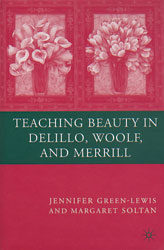
In a new book on literary studies, associate professors of English Jennifer Green-Lewis and Margaret Soltan celebrate the return of beauty to the literature classroom. Teaching Beauty in DeLillo, Woolf, and Merrill (Palgrave Macmillan, 2008) argues that studying the aesthetic value of a literary work can enlarge the imagination, inspire empathy, and reroute the reader to the intense, solitary experience that novels and poems offer. “We hope that professors, students— everyone who loves literature—regains a sense of confidence about responding to literature as a call to see the world more clearly, more compassionately, and more beautifully,” Dr. Soltan says. Dr. Soltan and Dr. Green-Lewis wrote the book in response to the political and theoretical emphasis in literature classes today. Professors and students alike are losing the ability to discuss the way beauty in writing affects them, and they feel uncomfortable discussing it in the classroom or in their written work, they lament. Hoping to examine the importance of literary aesthetics, the professors taught a course focused on beauty in modernist novels before collaborating on the book this past spring. Why should anyone study literature amid the ongoing global crises surrounding them? Dr. Green-Lewis and Dr. Soltan emphasize that readers can find order and consolation in writing. “As teachers of literature, the one thing we are really obliged to teach— whatever our theoretical approach; regardless of our political beliefs—is beauty,” the professors write. By focusing on how they respond to beauty in literature, students can be more confident about how they respond to the world around them, they say. Literature today is engulfed in its own crisis, as well, the professors add. Many in the academic community worry about the death of the book and the end of the written word. “The only thing we can do in response to these trends,” Dr. Soltan says, “is continue to make the case for the distinctive value of the intense, solitary, extended aesthetic experience that novels and poems offer.” —AH
GW-Battleground Poll Examines Election ’08
GW is known for its politically active student body and academic excellence in politics and public policy, so it’s no surprise that the University is a key sponsor of the Battleground Poll, a nationally recognized series of scientific surveys that provides an unparalleled view of the democratic process. The Battleground Poll, conducted by Republican pollster Ed Goeas and Democratic pollster Celinda Lake, is unique to the industry in that it offers the distinct perspectives of two top pollsters from different sides of the aisle. GW became a sponsor of the Battleground Polls in 2004, and the partnership brings resources to the nationally recognized poll and provides firsthand experience for GW students. The University’s role in the poll is guided by its Graduate School of Political Management, the nation’s first school for professional politics, and its dean, Christopher Arterton. A seasoned political operative, Dr. Arterton provides a moderating voice. He has several years of experience as a moderator, both on camera and for several pollsters. As dean, he has focused on all aspects of the political environment in the United States and has written extensively on the topic. Dr. Arterton also has served as a polling consultant for several Democratic campaigns at all levels of government. This year marks the poll’s 17th anniversary. Conducted by top polling firms Lake Research Partners and the Tarrance Group, the survey has accurately portrayed the political climate through four presidential and three mid-term election cycles. GW-Battleground Poll data can be found at www.tarrance.com, www.lakeresearch.com, or http://www.gwu.edu/~newsctr/battleground.cfm.
Integrating Statistics in Decision SciencesThere’s much more to statistics these days than crunching numbers and analyzing data. At the GW Institute for Integrating Statistics in Decision Sciences, scholars are fostering the use of modern statistical methodologies in the decision sciences. Established in January 2007 as a GW signature program with special endowment funding, the institute is directed by Refik Soyer, PhD ’85, professor of decision sciences and of statistics. A cross-disciplinary enterprise, the center is housed in the Department of Decision Sciences in the School of Business, in close collaboration with the Department of Statistics in the Columbian College of Arts and Sciences and the Department of Engineering Management and Systems Engineering in the School of Engineering and Applied Science. “One of the institute’s unique characteristics is its emphasis on Bayesian thinking in decision making when dealing with uncertainty,” says Dr. Soyer, an expert in the field who has published more than 80 papers on Bayesian statistics, reliability modeling, and statistical aspects of reliability analysis. Bayesian statistics enable researchers to bring subjective input—such as expert opinion, past experience, and qualitative data—to the analysis table. “We are one of the leading institutions in the world in the application of Bayesian statistics to reliability analysis and modeling,” he emphasizes, attributing the success to the pioneering work of his mentor, Nozer Singpurwalla, professor of statistics and of decision sciences and director of GW’s Institute for Reliability and Risk Analysis. The institute has a dual focus on research and education. Its work has widespread applications in the real world—from helping call centers operate at peak efficiency to dealing with privacy issues in data disclosure by developing methodologies such as data camouflaging (masking data to protect people’s privacy). —JLF
Protecting Produce: From Farm to Fork
A fresh salad can turn suddenly scary when reports of salmonella or E. coli outbreaks shake up the dining routine. Tomatoes, spinach, and strawberries are just a few culprits of nearly 713 pathogen-linked, food-borne incidents reported in the United States from 1990 through 2005, according to a Center for Science in the Public Interest survey. And most recently, that salsa favorite—the little green jalapeño—spread a sickening bacteria across the nation this past summer. Responding to the latest in a recent series of food contamination incidents, GW’s School of Public Health and Health Services released a report in July that examines the country’s vulnerability in its vast food infrastructure and explores strategies to reform how we harvest, process, inspect, and monitor our food—from the farm to the fork. In the paper, “Protecting the Nation’s Fruits and Vegetables: How Should the System Be Strengthened?”, the Rapid Health Policy Response Project, a group of students and professors at GW’s SPHHS, present comprehensive data on the challenges of a fragmented food safety regulatory system and examine the proposals from consumer advocates, industry trade groups, and legislators that call for more legal authority and resources for the FDA, and more industry accountability for preventing food safety problems. According to the report, while 15 federal agencies are in charge of administering at least 30 laws related to food safety, there are virtually no procedures or resources for monitoring foreign agricultural or food processing practices. The Food and Drug Administration, which oversees 80 percent of the food supply, including produce, generally focuses on response to food safety challenges after they occur, the report states. FDA inspectors rarely appear on farms, except after a disease outbreak, and their visits to domestic food plants may occur as seldom as every 10 years. Michael Taylor, SPHHS research professor and chair of the Food Safety Research Consortium, argues that current FDA guideline documents on produce safety are too general. “The documents say things like ‘minimize the potential of microbial contamination from water used with fresh fruits and vegetables.’ But we need specific standards—what is an acceptable level of contamination? An FDA that is playing a leadership role would drive the science and the research needed to set more specific standards,” Dr. Taylor says. Other proposals for prevention examined in the paper include increasing inspections, tightening procedures for imports, allowing the FDA to initiate mandatory recalls, and making it easier to trace contamination back to its source. Dr. Taylor formerly served as administrator of the USDA’s Food Safety and Inspection Service and as deputy commissioner for policy of the Food and Drug Administration. In July, he testified before the Oversight and Investigations Subcommittee of the House Committee on Energy and Commerce about the importance of creating a functioning system for investigating multi-state outbreaks. The Rapid Health Policy Response Project report can be downloaded at: http://www.gwumc.edu/sphhs/about/rapidresponse/Rapid_Fruits.cfm —JC
GW Hosts Science Olympiad National Tournament
Nearly 2,000 middle and high school students from across the country competed in the 2008 Science Olympiad National Tournament held at GW May 30-31. The 120 participating teams from 46 states conducted experiments and were quizzed on a wide range of topics spanning science, technology, engineering, and mathematics. The tournament is one of the country’s premier science competitions.
|
© 2008 The George Washington
University
|

